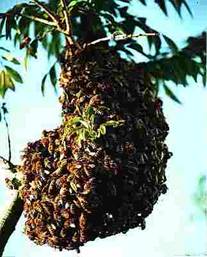What Do I Do If I Get Stung
Bees will not generally sting if unprovoked usually the bee has been trapped in hair or crushed. When close to a bee hive avoid flapping your arms and moving rapidly, if the bees are antagonised, walk away through undergrowth or trees if possible. If stung remove the sting quickly as the sting still pumps venom for some time after the bee has left. |

|
The record number of sustained stings one person has had, and survived to count them is 2,243. Ouch!
What Do I Do If I See A Swarm Of Bees

|
Don’t Panic, bees in a swarm are universally in a good mood. They cannot easily sting even if antagonised as they have gorged themselves with honey and cannot get their bodies into the best position to sting. If the swarm is not causing a nuisance then leave it, gradually the bees will cluster in a bush or tree and remain there for up to 3 days. During that time scouts will be sent out to look for a new home, the only problem may be they will choose your chimney so put your fire/ heating on low and enjoy their visit. If the swarm is a nuisance then the police usually keep a list of local beekeepers that can help. |
Apart From Honey Are Bees Useful
Yes very, the pollination benefit of bees is calculated to help the economy by millions of pounds per annum. Certain crops yield up to 25-40% more if efficiently pollinated and farmers in some areas of the world and in South Africa, pay beekeepers to put hives into their fields and orchards. In the USA alone bees pollinate about ten billion dollars worth of crops per year (1997). In addition to pollination, bees produce wax for candles and Royal Jelly. During the middle Ages one of the most important jobs in an Abbey was the Beekeeper, as a huge quantity of wax was constantly required for the ceremonial candles.
Is Beekeeping Hard Work
In terms of time… about ½ an hour per hive per week from mid September - February. In addition honey is extracted twice a year.
The first record of people keeping bees was in Spain about 6000BC
How Much Will It Cost Me To Keep Bees
For the clothing and tools about R4250 and a hive with queen excluder about R1090.
Will I Get Stung If I Keep Bees
Yes. A few people are allergic, but most will swell for a short time and then gradually become more immune. Make sure you carry anti-histamine tablets with you (R80 for 20).
A Beekeeper Uses Smoke To ‘Calm’ The Bees, How Does This Work
Bees are woodland insects and evolution has taught them to fear fire more than anything else. When smoke enters a hive the bees are immediately diverted to eat as much honey as possible as there may be a need to abandon the hive at a moment’s notice. This diverts them whilst the beekeeper takes their home apart.
I Have Honey Bees inside a Wall/Roof How Can I Remove them Humanely
This is a question that comes up from time to time and here is a typical reply that I have given.
The bees cannot* be removed without gaining physical access to them and making them swarm (even if you could) would not get rid of them only reduce their numbers transiently. They will swarm anyway most years, between September-February. Swarms are not normally dangerous only dramatic.
You have three choices:
1) Remove the floor/ceiling and get a good beekeeper to assist. The amount of hassle does not justify the gain of bees so expect to be charged at least R700 for the assistance of a beekeeper.
2) Live with them they will make good neighbours, so long as the entrance is +2m above ground and the floor and ceiling are good i.e. they cannot bleed into the house. They are not likely to be aggressive if undisturbed by significant vibration and they will keep all their honey well sealed so you will not get natural leakage.
The gardner however may end up being a target when moving the lawn. So take precaution here.
3) Kill them; that would be a shame. This is a resort when bees become too large for space they are inhabiting and the hot summer heat in SA aggrevates them. They will react to grass and trees being cut at this time. If you or the beekeeper decides to exterminate the bees, ensure that there is no escape into the house.
Other products available...
[Bee Gloves] [Bee suits] [Hive Tools] [Hives] [Smokers] [Blue book]
|
